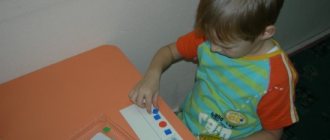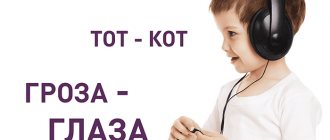Development of the phonetic-phonemic side of language in ontogenesis
The phonetic-phonemic side of the language is an indicator of the general culture of speech, the compliance of the speaker’s speech with pronunciation norms.
The phonetic side of speech refers to the pronunciation of sounds as a result of the coordinated work of all parts of the speech-motor apparatus.
The peripheral department of the speech motor analyzer is the speech apparatus, which includes the following:
- The respiratory apparatus, which is the energetic basis of speech (diaphragm, lungs, bronchi, trachea, larynx);
- The vocal apparatus that produces sound (larynx with vocal folds);
- An articulatory apparatus that converts sound produced in the larynx into various speech sounds (oral and nasal cavities).
The conducting part of the analyzer includes three pairs of cranial nerves (glossopharyngeal, recurrent, sublingual), subcortical formations that provide information transmission to the cerebral cortex.
The central part of the speech motor analyzer is the parietal cortex, which analyzes information about the position of the organs of the speech apparatus during speech, and the frontal or Broca's center, which programs and controls the execution of movements. The phonemic aspect of language refers to the ability to distinguish and differentiate phonemes of the native language.
The phonemic aspect of speech is provided by the work of the auditory analyzer. Its peripheral part is located in the cerebral cortex and receives auditory information, including speech sounds.
The conductive part transmits information to the cerebral cortex, which partially analyzes it - determines the direction and distance to the sound source. This function is performed by a large number of transmission connections (VIII. pair of cranial nerves, medulla oblongata, cerebellum, midbrain, medial geniculate body and auditory radius).
The central part of the auditory analyzer is the temporal region of the speech dominant hemisphere (the left hemisphere in right-handed children), Wernicke's center, where speech analysis takes place: It controls the presence of sound in a word, the characteristics of its positional sound, the number and order of sounds in a word, the discrimination of sounds similar in acoustic parameters.
In the book “Educating Correct Pronunciation in Children” M.F. Fomicheva emphasizes that the perception and reproduction of the sounds of the native language is a coordinated work of the linguo-auditory and linguomotor analyzers, where a well-developed phonemic hearing allows one to develop clear diction - mobility and subtle differentiated work of the articulation organs, which ensures the correct pronunciation of each sound (1989).
Research by a number of psychologists, educators, and linguists (D.B. Elkonin, A.R. Luria, D.N. Bogoyavlensky, F.A. Sokhin, A.G. Tambovtseva, G.A. Tumakova, etc.) confirms that basic awareness of the phonetic features of a spoken word also affects the child’s overall language development—the acquisition of grammar, vocabulary, articulation and diction. And it is better that a child with language impairment not only goes to school phonetically correct, grammatically correct and lexically developed, but also knows how to read.
In ontogenesis, the development and formation of the phonetic and phonemic aspects of language occurs gradually.
The main role in language acquisition is played by hearing. Along with the development of hearing, the child develops vocal reactions: various sounds, various combinations of sounds and syllables. At the age of 2-3 months, the child begins to growl, and at the age of 3-4 months, slurred speech... babble. At this age, the primary development of phonemic hearing occurs: The child listens to sounds, finds the source of the sound, and turns his head towards the speaker.
At 6 months, clear sounds appear in the child’s babble, but they are not yet stable enough and are pronounced in the form of short combinations of sounds. In vowels, a clearly sounds, in consonants - p, b, m, k, t. At this stage, the child understands the adult’s intonation and reacts to the tone of voice.
The child pronounces simple sounds well: Vowels - a, u, and consonants - p, b, m, n, t, e, k, d.
The development and formation of pronunciation in all children occurs at different times. Some children speak more and more clearly, others less and less clearly. The quality of pronunciation depends on the condition and mobility of the articulatory apparatus, which is just beginning to actively function. About this A.I. Maksakova.
Development of phonemic hearing
In modern pedagogical, psychological and methodological literature, various terms are used to define phonemic listening: speech auditory processing, phonemic auditory processing, phonemic awareness.
The term "speech hearing" refers to the ability to distinguish individual speech sounds in a speech stream, which allows you to understand words and their meanings. Speech communication is impossible without speech hearing. Children develop their listening skills by listening to others speak or creating their own words. Listening to language is an integral part of language intuition. As children learn to read and write, the mechanism of speech perception changes as the ability to analyze letters and sounds according to the rules of their native graphic language develops. All this is connected with the need for orientation in the morphemic composition of words and word formation. Methods for developing speech hearing are different: listening and speaking practice; phonetic analysis and synthesis, etc.
In the methodological literature on Russian methods of speech and language development, the term “speech hearing” is used. In psychological research and speech therapy, listening to speech is called phonemic awareness.
In the first weeks of a child’s life, auditory attention is actively formed. When a baby hears the sound of a human voice, it stops suckling at its mother's breast and stops crying when spoken to. By the end of the first month, the baby can be soothed with a lullaby. At the end of the third month of life, he turns his head towards the speaking person and follows him with his eyes. During the babbling period, the child repeats and tries to imitate the visible articulation of the adult's lips. Repeated repetition of the kinesthetic sensations of a certain movement leads to the consolidation of the motor ability of articulation. From 6 months, the child imitates individual sounds and syllables and adopts the tone, tempo, rhythm, melody and intonation of speech. By the age of two, children are already able to recognize the subtleties of their native language, understand and respond to words consisting of only one phoneme. Thus, the child develops phonemic awareness, the ability to perceive the sounds of human speech.
From 3 to 7 years, the child increasingly develops the ability to auditory control over his pronunciation, and the ability, in some cases, to correct it. At the age of 3-4 years, the child’s phonemic perception improves so much that he begins to distinguish between vowels and consonants, then soft and hard, sleepy, hissing and whistling. At the age of 4 years, a child should normally distinguish all sounds, that is, phonemic perception should be formed. At the same time, the child completes the formation of correct pronunciation.
The development of sound pronunciation depends on the child’s ability to analyze and synthesize speech sounds, that is, on a certain level of development of phonemic hearing, which ensures the perception of speech phonemes. Phonemic perception of speech sounds occurs through the interaction of auditory and kinesthetic stimuli entering the cerebral cortex. Gradually, these stimuli become differentiated, and it becomes possible to distinguish individual phonemes. Here, primary forms of analytical-synthetic activity play an important role, thanks to which the child generalizes the characteristics of certain phonemes and distinguishes them from others.
Through analytical and synthetic activity, the child compares his imperfect speech with the speech of his elders and forms a healthy pronunciation. Lack of analysis or synthesis usually hinders the development of pronunciation. However, if the presence of primary phonemic hearing is sufficient for everyday communication, then it is not enough for mastering reading and writing.
A.N. Gvozdev, V.I. Beltyukov, N.Kh. Shvachkin, G.M. Lyamina proved that it is necessary to develop higher forms of phonemic hearing, in which children can decompose words into their constituent sounds, determine the order of sounds in a word, i.e. analyze the sound structure of a word.
D.B. Elkonin called these special actions of analyzing the sound structure of words phonemic awareness. In the context of literacy acquisition, these activities are formed through a process of special education in which children are taught the means of sound analysis.
Features of the development of the phonetic structure of speech of preschool children ONR article on the topic
Features of the development of the phonetic structure of speech of ONR preschool children
With general underdevelopment of speech in children, the formation of the main components of the speech system is impaired or lags behind the norm: vocabulary, grammar, phonetics. Speech impairment in preschoolers can vary from a complete lack of common speech to the presence of extensive speech with pronounced manifestations of lexico-grammatical and phonetic-phonemic underdevelopment [Filicheva, 2013]
Studying the causes of phonetic-phonemic disorders G.V. Gurovets, S.I. Mayevskaya revealed that they are based on disorders of various levels and parts of the nervous system [Gursky, 2015]
Difficulties in mastering sound pronunciation are common in children of older preschool age with OHP.
In case of violation of the phonetic-phonemic aspect of speech in children with OHP G.R. Shashkina identifies several conditions:
- insufficient differentiation and difficulty in analyzing only those sounds that are impaired in pronunciation (the mildest degree of underdevelopment);
- violation of sound analysis, insufficient differentiation of a large number of sounds belonging to different phonetic groups when their articulation is formed in oral speech;
- not the difference in sounds in a word, the inability to isolate them from the composition of the word and determine the sequence (severe degree of underdevelopment) [Shashkina, 2012].
Pronunciation errors are assessed in different ways: some affect only the shades of phonemes and do not violate the meaning of the utterance, others lead to confusion of phonemes, to their differentiation. The latter are more rude, as they make the statement more difficult to understand.
Children with a disorder in the formation of phonemic processes experience general blurred speech, insufficient expressiveness and clarity [Shashkina, 2013]
Features of the sound side of speech and phonemic perception were first presented in the works of R.E. Levina
In children of the first level of speech development, the phonetic-phonemic aspect of speech is characterized by phonemic uncertainty and unstable phonemic design. The pronunciation of sounds is diffuse, which is due to unstable articulation and low auditory recognition capabilities. Such children may have more defective sounds than correctly pronounced ones.
In the pronunciation of children of the first level of speech development, only vowels - consonants, orals - nasals, plosives - fricatives are opposed to each other. Phonemic development is in its infancy: the task of isolating individual sounds for a child with such development is incomprehensible and impossible [Levina, 1978].
The phonemic aspect of speech of children at the second level of speech development is characterized by the presence of many distortions, substitutions and confusions; they have impaired pronunciation of soft and hard sounds, hissing, whistling, affricates, voiced and voiceless. At the same time, children can pronounce sounds that are in an isolated position correctly; errors occur during spontaneous pronunciation. When correctly reproducing the contour of words, their sound content is disrupted (“morashki” instead of chamomile)
According to T.B. Filicheva, G.V. Chirkina, the replacement of some sounds with others, simpler in articulation, is most often found in the group of sonorant sounds “dyuka” instead of ruka, “palokhod” instead of steamer), whistling and hissing (“totna” instead of pine, “duk” instead of beetle). Confusion most often concerns iotized sounds and sounds l, g, k, x, while distortion of the articulation of some sounds is observed (interdental pronunciation of whistling and hissing sounds, guttural r) [Filicheva, 2012: 69].
One of the characteristic features of children at level II of speech development is insufficiency of phonemic perception, unpreparedness to master the skills of sound analysis and synthesis.
Children of the III level of speech development are characterized by undifferentiated pronunciation of sounds (whistling, hissing, sonorant) when one sound simultaneously replaces two or more sounds of a given or similar phonetic group (the sound s replaces the sounds s, sh, ts, ch, sch) In addition, sounds complex in articulation are replaced by simple ones (f or t replace a group of whistling or hissing sounds, the sound й - sounds l, r).
In children with OHP, sound pronunciation is impaired according to the type of dyslalia, dysarthria or rhinolalia. To assess the characteristics of sound pronunciation disorders, it is necessary to conduct an appropriate examination. [Shashkina, 2013].
If there are a large number of defective sounds in children with OHP, the syllable structure and pronunciation of words with a combination of consonants are disrupted. There are errors when conveying the sound content of words: rearrangements, abbreviations and replacements of sounds and syllables. Correctly repeating complex words after a speech therapist, children often distort them in their independent speech, usually reducing the number of syllables (instead of: children made a snowman - “children wheezed a new one”) Many errors are observed when conveying the sound content of words: permutations of replacing sounds and syllables, abbreviation when consonants coincide in the word (“tovotik” instead of tummy). Typical for children are perseverations (astobus-bus); adding extra sounds and syllables (lemon-lemon) [Fomicheva, 2012: 116]
Researchers note that the nature of errors in syllabic composition is determined by the state of the child’s sensory (phonemic) or motor (articulatory) capabilities. Errors expressed in the rearrangement or addition of syllables indicate a primary underdevelopment of speech in the child’s auditory perception. Errors such as reducing the number of syllables, assimilating syllables to each other, contraction, confluence of consonants indicate a predominant violation of the articulatory sphere, and are more stable in nature.
The nature of impaired sound pronunciation in children with OHP indicates a low level of development of phonemic perception. Phonemic underdevelopment of children in this group is manifested in the lack of formulation of the processes of differentiation of sounds. Underdevelopment of phonemic perception is noted when performing elementary actions of sound analysis. Children with OHP experience difficulties when they are asked, while listening carefully, to raise their hand at the moment of pronouncing a particular sound. The same difficulties arise when repeating syllables with paired sounds after a speech therapist, when independently selecting words that begin with a certain sound, when making the initial sound in a word, when selecting pictures for a given sound.
Many authors (Levina R.E., Orfinskaya V.K., Kashe, G.A., Filicheva T.B., Mastyukova E.M., etc.) pointed out the insufficient differentiation of phonemic perception in children with general speech underdevelopment. (G.A. Kashe, V.K. Orfinskaya, T.B. Filicheva).
A sign of phonemic underdevelopment is the incompleteness of the process of formation of sounds distinguished by subtle articulatory or acoustic features. The lack of formation of sounds is expressed in the following:
- replacing sounds with simpler ones in articulation (voiced ones are replaced by unvoiced r and l with the sound l and yot, s-sh or f, etc.);
- unformed process of differentiation of sounds (instead of several articulatory-close sounds, the child pronounces an indistinct sound, for example, a soft sound [w] instead of [w];
- The child is able to pronounce some sounds correctly in isolation, but does not use them in speech or replaces them. For example, a child correctly pronounces simple words dog, fur coat, but in coherent speech there is a mixture of sounds s and sh;
- There is an unstable use of sounds in speech. A child pronounces the same word differently in different contexts or when repeated several times [Mastyukova, 2011].
The number of incorrectly pronounced sounds can reach a large number (up to 16-20). Most often, whistling and hissing sounds ([s], [s], [z], [z], [ts], [sh], [zh], [h, [sch]), sounds [t], [d], sounds [l], [r]. [рь], voiced ones are often replaced by paired unvoiced ones, less often, some pairs of soft and hard sounds are not sufficiently contrasted, there is no unpaired soft consonant [iot], vowel [s].
Children have difficulty when they are asked to listen carefully and raise their hand (chips, signal card, etc.) at the moment of pronouncing a certain sound or syllable. No less difficulties arise when repeating after a speech therapist syllables with paired sounds (for example, pa-ba, ba-pa), when independently selecting words that begin with a specific sound, when identifying the sound at which a word begins, etc. Most children experience significant difficulties when it is necessary to select, using pictures, words that begin with a specific sound [Kache, 2009].
Analysis of literary data showed that phonemic hearing is one of the earliest forming sensory processes. As evidenced by the observations of R.E. Levina, V.K. Orfinskaya, N.H. Shvachkina, already in newborns there is sensitivity to sounds, which reveals itself as a change in the general motor activity of the child, a violation of the frequency and rhythm of breathing.
Thanks to the early development of phonemic hearing, the child learns for the first time to distinguish between various phonemic elements and their precise auditory representations, which become a regulator for the development of these elements in his own pronunciation [Shvachkin, 2009].
The development of phonemic perception determines the formation of the child’s entire phonemic system, and subsequently the process of mastering oral and written speech. The significance of the problem of studying the phonemic system in preschool children with general speech underdevelopment requires constant adjustment of the directions of speech therapy work on the formation of phonemic processes.
Bibliography
Gorelov I. N. Selected works on psycholinguistics / I. N. Gorelov - M.: Labyrinth, 2013. 241 p.
Gurovets G.V., Mayevskaya S.I. Genesis, clinic and main directions of work in motor alalia / G.V. Gurtsky G.V. Mayevskaya // Underdevelopment and loss of speech: issues of theory and practice. - M., 2015. No. 12. pp. 12-14.
Kashe G.A. Preparing children with speech impediments for school: a manual for speech therapists / G.A. Porridge. –– M.: Education, 2009. – 207 p.,
Levina R.E. The role of research from the Institute of Defectology in the development of the theory and practice of speech therapy / R.E. Levina // Fifth scientific session on defectology. M., 1967. 315 p.
Levina R.E. On the problem of mastering the phonetic side of speech in childhood / R.E. Levina, R.M. Boskis // Soviet pedagogy. -1978. No. 6. pp. 144-154.
Levina R.E. Delineation of speech development anomalies in children / R.E. Levina // Defectology. 1975. No. 2. P. 12-16.
Mastyukova E. M., Ippolitova M. V. Speech impairment in children with cerebral palsy: book. for a speech therapist. —— M.: Education, 2011. 297 p.
Orfinskaya, V.K. Controversial issues in teaching hearing children without speech / V.K. Orfinskaya. – L.: LGPI im. A. I. Herzen, 1959.128 p.
Pavlyuk, E. Let’s explore the world together: correctional and speech therapy work with children of senior preschool age with ODD in the conditions of a preschool educational institution / E. Pavlyuk // Preschool education. 2010. No. 3. P. 80-85.
Filicheva T.B. Children with general speech underdevelopment. Education and training: educational and methodological manual / T.B. Filicheva, T.V. Tumanova. - M.: GNOM i D, 2012. 194 p.
Filicheva T.B. Preparing children with general speech underdevelopment for school in a special kindergarten: a textbook for students of defectology faculties, pedagogical workers of special institutions, kindergarten teachers and parents / T.B. Filicheva, G.V. Chirkina. - M.: MGZPI, 2014. -188 p.
Filicheva T.B. Features of speech formation in preschool children: dis. ... dr. ped. sciences in the form of a scientific report / T.B. Filicheva. M., 2011. 148 p.
Fomicheva M.F. Education of correct sound pronunciation in children: Workshop on speech therapy / M.F. Fomicheva.–– M.: Education, 2012. 239 p.
Shashkina, G. R. Speech therapy rhythm for preschoolers with speech disorders: textbook. aid for students higher ped. textbook institutions / G. R. Shashkina. – M.: Academy, 2012. 192 p. Shashkina G.R. Speech therapy work with preschoolers: textbook. aid for students higher ped. textbook institutions / G. R. Shashkina, L. P. Zernova. – M.: Academy, 2013. 240 p.
Shvachkin N.Kh. Development of speech forms in a younger preschooler. Questions of psychology of a preschool child: Sat. Art. / Rep. ed. A.N. Leontiev, A.V. Zaporozhets. M., 2009. 143 p.





